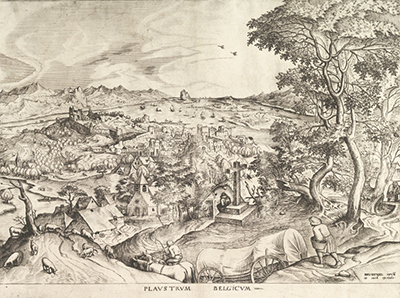Bruegel the Elder was a painter, first and foremost, but he also possessed skills within the discipline of etching and engraving. The Belgian Wagon, found here, was printed from an engraving that he passed on to others in order to publish the artwork.
The artist was from what we now refer to as Belgium and within this artwork we can quickly understand why it is known as the lowlands, as well as being famous flat. This allows a very precise implementation of perspective within this composition, with clear lines coming in from the left and right which slowly converge in the distant part of the work. Perspective is something that we take for granted within art, but for many years it was actually handled in a very different way, leading to many paintings in the middle ages looking flattened. Within The Belgian Wagon, Bruegel places a tall tree in the foreground on the right which serves the purpose of framing the rest of the content. He also places a single figure, looking out over the rest of the scene in a similar way to how Friedrich would work within the German Romanticist era, gifting us the likes of Wanderer above the Sea of Fog, Moonrise over the Sea and The Monk by the Sea.
The Belgian Wagon, as with all of this series of engravings, was produced in a team effort of Bruegel alongside some other highly skilled artists. After some serious research into this series of landscape engravings, it has been determined that actually Bruegel's role was to design the various artworks, and then hand them over for others to produce the engravings and then provide the printed sheets. Joannes van Doetecum I and Lucas van Doetecum would create the engravings once his work had been completed and Bruegel must have fully trusted their expertise in order to hand over these duties to them. Once the engravings were ready, they would be passed over to Antwerp-based, Hieronymus Cock, who was a famed publisher with a wealth experience in these types of requirements. The printed designed could then be sold on, with each contributor taking a share of the proceeds.
The Metropolitan Museum of Art in New York own the engravings and some of the prints from this series amongst their impressive collection of European art, which includes both notable paintings and sculptures. Opening of the Fifth Seal by El Greco, The Musicians (1595) by Caravaggio and The Death of Socrates by Jacques Louis David are three of the real standout pieces, but there is simply to much to enjoy that could effectively be summarised here. It has to be considered amongst the most important art galleries or museums in the world, ranking favourably against the likes of the Louvre, MoMA and the National Gallery in London. It is also pleasing to see traditional art still enjoyed today by large numbers across the world, with artists such as Bruegel still retaining their status as household names.




